- Introduction
to Odissi dance, the classical dance style of Orissa. Article also covers the
origin and evolution of this dance form.
Odissi
is one of the most elegant classical dance styles of India, hailing from Orissa
and is based on the feminine style of dancing known as “Lasya”. Prevailing for
more than two thousand years, evidence reveals that Odissi existed in the 2nd
century, but over the years, Odissi, went through various stages of both
progression and regression like other classical dance styles of India. Through
the medium of varied movements, gestures and gesticulations, varied stories
from Hindu traditions are portrayed, mainly based on Vaishnavism (worship of
Vishnu).
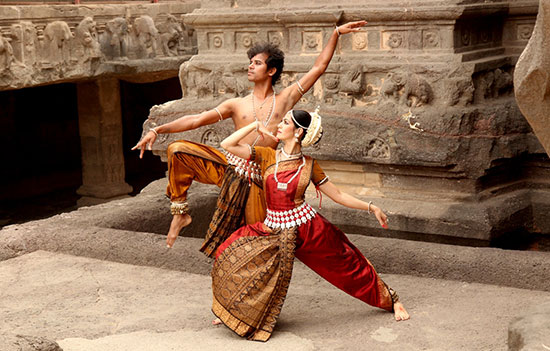 Odissi dancer
Anandini, born Argentina, with her Guru Arun P at Kailasa Temple, Ellora.
Odissi dancer
Anandini, born Argentina, with her Guru Arun P at Kailasa Temple, Ellora.
Evolution and History
Odishee
(original name) archaeological sites related to Hinduism, Buddhism and Jainism
and the carvings of dance and music in the Manchapuri cave in Udayagiri,
reveal that Odissi existed in 1st to 2nd century, during
the reign of Jain King Kharavela.
Hathigumpa inscriptions also substantiate the existence of this graceful
and lyrical classical dance style of India.
The
Shilpa Prakasha Odia architecture and
sculptures at the Lord Jagannath Temple, the Konark Temple with a Nritya mandapa, the Brahmeshwara Temple
in Bhubaneshwar are other evidences of the Odissi form. The 8th
century saw the emergence of the saint composer and philosopher Shankaracharya
and in the 12th century, the saint composer Jayadeva wrote the
immortal classic known as Geet Govinda
(love between Krishna and Radha) which is considered the mainstay of the Odissi
repertoire.
See pics 1
and 15 of Sun Temple Konarak album for Nritya Mandapa
To
read briefly about Geet Govinda
Read
How
Geeta Govinda inspired India at a turbulent time
Video
1 hour by Suresh Wadkar
on Geet Govinda
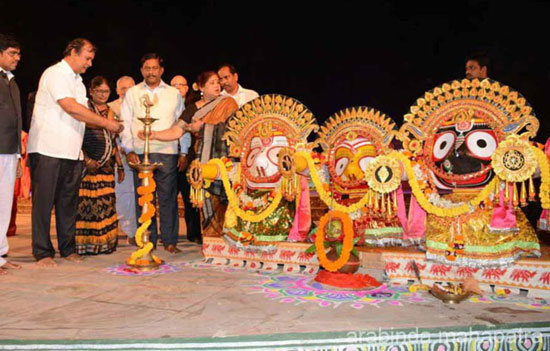 Lighting Lamp at Konarak Festival i.e. held from Dec1-5 every year.
Lighting Lamp at Konarak Festival i.e. held from Dec1-5 every year.
Odissi
dancers were referred as Maharis (devadasis).
Dancers would perform inside the sanctum sanctorium (refers to Jagannath Mandir) and there were other dancers who would perform in the courtyards and temple premises. Slowly the dancers drifted away and started performing for rich landlords and palaces, that’s when the degradation of dance started. For this the dancers and society were equally responsible. Alongside the traditional emergence of gotipua (boy dancers)
prevailed wherein young boys, attired like girls, would dance.
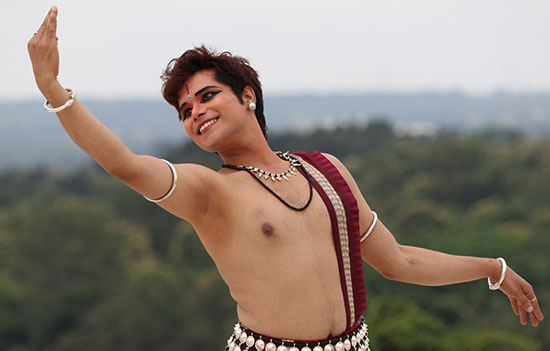 Deb Pattnaik.
Deb Pattnaik.
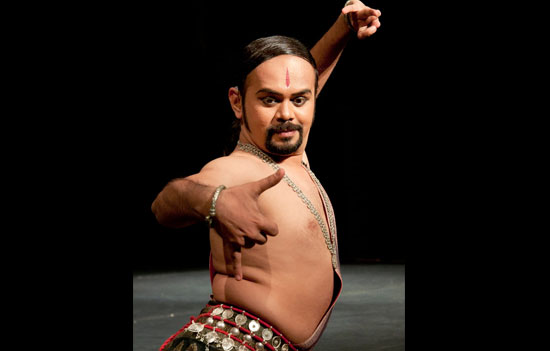 Ankur Ballal.
Ankur Ballal.
Technique and music
Like
other classical dance styles Odissi is broadly based on texts like Bharatas
Natya Sastra, Nandikesvarao’s Abhinaya Darpana etc.
Natya
Sastra mentions four vrittis (methods
of expressive delivery) like Avanti, Dakshinatya, Panchali and Odhra Magadhi.
Odra refers to Odissi. Odissi technique pertains to various bhangas (symmetry body bends), torso
deflections and hand gestures. The training starts with the basic chauka (half seated) posture, following
with varied pada bhedas feet
positions with simultaneous hand movements moving in varied rhythms.
Broadly
the technique can be divided into two sections, pure dance concerning varied
bodily movements and expressional dancing. Students start learning at a tender
age as it is not easy to master this art form of geometrical symmetry and
stylized movements.
Classical
and folk music with Odia lyrics with ragas like Kalyana, Nata, Baradi, Karnata, Bhairavi, Saveri etc. are used. Music composers
like Jayadeva, Dinakrisha Dasa, Kabi Samrata, Upendra Banja, Banmali Das and
Kavichandra Kalicharan Pattnaik and Raghunath Panigrahi form the mainstay of
the Odissi repertoire
The
performance commences with the number of invocations to Lord Jagannath,
presiding deity of Odissi dance, also known as Mangalacharan. This is followed
with pure dance known as Pallavi
which forms a fine synthesis of music, melody and rhythm. It is similar to Jatiswaram in Bharata Natyam. Abhinaya numbers like Dashavataram and
ashtapadis of Jayadeva are considered the highlight of Odissi dance.
The
performance concludes with Moksham
which symbolises the union of the human soul with the Almighty.
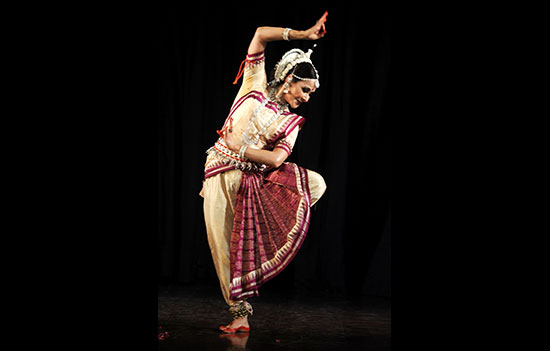 Pooja Kumar
Pooja Kumar
Pioneer mentors and top dancers
Pioneer
mentors are Guru Pankaj charan Das, Gangadhar Pradhan, Guru Kelucharan
Mohapatra, Raghunath Datta and Guru Rabindra Atibudhi from Mumbai. Top dancers
are Sanjukta Panigrahi, Sonal Mansingh. Ragini Devi placed Odissi on the
international map followed with Dr Priyambada Mohanty, Ahalya Hejmadi, Kum Kum
Mohanty, Kum Kum Lal, Madhavi Mudgal, Kiran Segal and Kasturi Pattnaik, Aruna
Mohanty, Aloka Kanungo, Guru Bichitrananda Swain, Guru Gajendra Panda and his
disciple Arya Nanda who further enhanced the repertoire with new choreography.
Sharon Lowen from America, Illeana Citaristi
from Italy, Ramli Ibrahim from Malaysia are devoted performers.
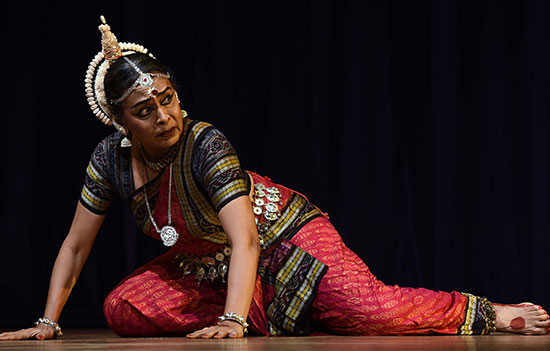 Jhelum Paranjape. Drapuadi thrown in the royal court
Jhelum Paranjape. Drapuadi thrown in the royal court
Some
of the professional dancers from Mumbai are Jhelum Paranjape, Debi Basu, Daksha
Mashruwala, Shubhada Varadkar,Anandi Ramachadran etc. Young dancers like Madhur
Gupta and Pooja Kumar,disciples of Sharon Lowen, Vinod Kevin Bachan, disciple
of Guru Ranjana Gauhar,Ankur Balal, Rupali Desai , Namrata Mehta, Dhara Dutta,
Debasis Pattnaik etc
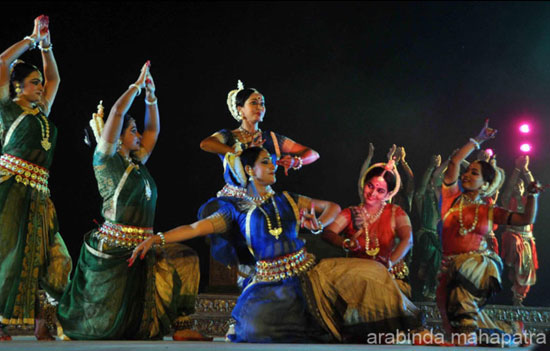 Prakruti Purusa,
Khamaj Pallavi and Krishna Saranam were presented marking the evolution of
Odissi as a typical classical dance form. Konarak Dance Festival 2015.
Prakruti Purusa,
Khamaj Pallavi and Krishna Saranam were presented marking the evolution of
Odissi as a typical classical dance form. Konarak Dance Festival 2015.
Guru Pankaj Charan Das belonged to the traditional family of Maharis, was born in 1925 and was among
the foremost mentors. He said, “I was born in a Mahari family and my first lesson
began in this tradition, at that time the Mahari tradition was on a low ebb as
Mahari dancers in the Jagannath temple were decreasing. The Maharis were
degraded, due to their lack of faith in religion and the political manipulation
since Muslim rule for carnal desires. Since my childhood I had to struggle hard
for my survival, as dance as my sole profession and by 1946, I could become a
dance director of the Annapoorna theatre.
There
was a drama called Abhiseka that was
staged that year, which had dance sequence and for the first time, I introduced
the dance I learnt from my tradition and named it devadasi dance. My first disciple Laxmipriya danced superbly and another
disciple, Kelucharan, appeared as a madeli
(drummer). This dance sequence was well appreciated and the same was
presented again.
When
India’s first Governor General C Rajagopalachari visited Cuttack in 1946,
Rajaji was particularly fascinated by this dance and wanted to know the
original name of this dance was. The then manager of the theatre company BB
Mohanty and L Nanda, being enthusiasts of Odia culture named the dance as Oriya Nata.
Subsequently, the
same Oriya Nata became Odissi Nritya and slowly started gaining reputation as
girls from higher strata of the society also started learning Odissi. When I
named the Odissi earlier as Devadasi dance or Oriya Nata it was simply because
of my inferiority complex and since the maharis were degraded I was afraid of
calling it Mahari Nritya.
However,
with the emergence of the dance style, many learned and established persons,
came up to interpret this dance in their own way as Odissi was being reformed
and reinvented. Organisers of various cultural organisations, without proper
research, codified and formulated a system of training and I had to adapt to it
as it was the question of my survival and there was no alternative.
Guru
Pankaj Charan Das learnt his first lesson from his aunt, Ratnaprabha Mahari and
later from Ranganath Dev Goswami and Bhakari Charan Dalia both of whom were exponents
of Raslila movement in Orissa. From 1942 to 1948 he was dance director of
Annapoorna Theatre in Cuttack, the only theatre company to run daily shows. Due
to his enriching and outstanding contribution to Odissi dance, he was awarded
the Kendriya Sangeet Natak Akademi award in 1970 and the Orissa Sangeeta Natak
Akademi award in 1971.
“The Mukteshwar Dance Festival concentrates exclusively on Odissi dance. It features solo, duet and group Odissi performances by young and senior artists. It takes place in the courtyard of one of Bhubaneswar's most prominent and well preserved temple
complexes that's more than 1,100 years old.” Source The Konarak Dance Festival features
various Indian Classical Dances. To see album
Guru Vijay Shanker is a professional Kuchipudi, Kathakali
exponent, dance teacher, choreographer, actor and arts critic for over four
decades, contributing for national and international publications. He is
particularly credited for his lecture-demonstrations on Indian classical
dancing which is a fine combination of both education and entertainment.
To read all articles on
Indian Dance
To read all
articles by author on Indian Classical Dance Forms
Also read
1.
A
good article on Odissi dance and its evolution through time
2.
Odissi
dance on Odisha Tourism site
3.
The
Dance Divine
4.
Odissi Dance Company USA